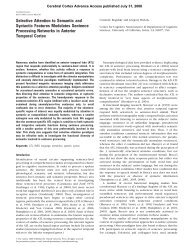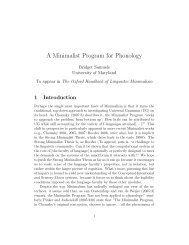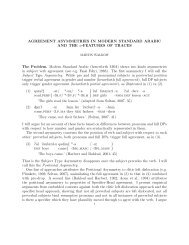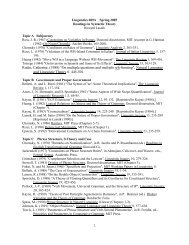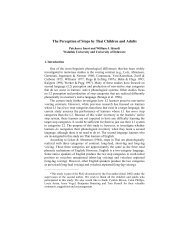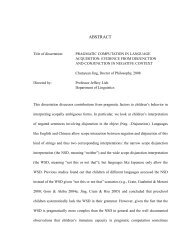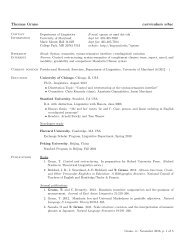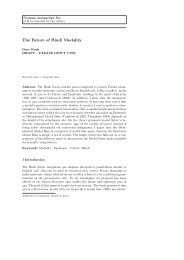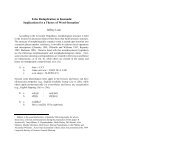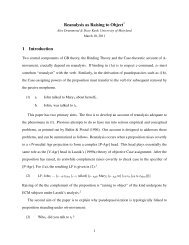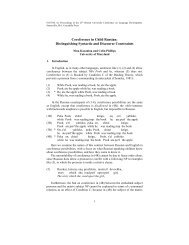Homework #2: Phonology Problems
Homework #2: Phonology Problems
Homework #2: Phonology Problems
You also want an ePaper? Increase the reach of your titles
YUMPU automatically turns print PDFs into web optimized ePapers that Google loves.
<strong>Homework</strong> <strong>#2</strong>: <strong>Phonology</strong> <strong>Problems</strong><br />
Your answers should be typed or written very neatly. (This is a graded assignment worth<br />
10 points). Due on Thursday.<br />
1. Korean (3 points)<br />
In the following Korean words, you will find the phones (or sounds) [s] and [ß].<br />
Determine whether these sounds are allophones of the same phoneme or allophones of<br />
separate phonemes. If the sounds are allophones of separate phonemes, give your<br />
evidence. If the sounds are allophones of the same phoneme, write a rule showing which<br />
sound is basic and which one is derived and what environment conditions the derived<br />
allophone. (i.e., what environment the derived allophone occurs in)<br />
Note: [ç] ≈ [tß]<br />
[ßi] ‘poem’<br />
[sal] ‘flesh’<br />
[mißin] ‘superstition’ [çasal] ‘suicide’<br />
[ßinmun] ‘newspaper’ [kasu] ‘singer’<br />
[t h aksa˜ßige] ‘table clock’ [sanmun] ‘prose’<br />
[ßilsu] ‘mistake’<br />
[kasəl] ‘hypothesis’<br />
[oßip] ‘fifty’<br />
[çə˜sonjən] ‘adolescents’<br />
[çaßin] ‘self’<br />
[miso] ‘smile’<br />
[pa˜ßik] ‘method’ [susek] ‘search’<br />
[kanßik] ‘snack’<br />
[tapsa] ‘exploration’<br />
[kaßi] ‘thorn’<br />
[so] ‘cow’<br />
To get full credit for these problems, you need to show every step of your work. If there<br />
are no minimal pairs, give a chart with all of the environments that each sound occurs in.<br />
Make generalizations about these environments and state whether there is complementary<br />
distribution. State which sound represents the basic phoneme. THEN, write a rule as<br />
described above.<br />
Note: be sure to record the environments for every instance of the sounds. In some cases<br />
two of the sounds (either one of each or two of the same sound) occur in the same word.<br />
Make sure to include both in your chart.<br />
(more problems ->)<br />
1/3
2. English vowel nasalization (2.5 points)<br />
In English, some vowels are pronounced with nasalization (the velum lowers to let air<br />
flow through the nasal cavity), whereas other vowels are oral. Nasalization is indicated<br />
by putting a “ ~ ” above the vowel. E.g., [å~] is a nasalized [å]. Examine the distribution of<br />
oral and nasal vowels in the data below.<br />
bean [bi~n] bead [bid] sick [sIk]<br />
bin [bI~n] bid [bId] leak [lik]<br />
roam [ro~¨~m] robe [ro¨b]<br />
boom [bu~m] be [bi]<br />
bomb [bå~m] lay [leI]<br />
lame [le~I~m] lace [leIs]<br />
bang [bæ~˜] bad [bæd]<br />
a. Is nasalization a constrastive (distinctive) feature of vowels in English? That is, are<br />
nasalized [i~] and oral [i] allophones of the same phoneme or are they allophones of<br />
separate phonemes?<br />
b. If nasal and oral vowel pairs are allophones of separate phonemes, give evidence for<br />
this. If they are allophones of the same phoneme, give a rule that derives the allophones<br />
from the underlying phoneme. (Make the rule as general as possible, referring to natural<br />
classes of speech sounds.)<br />
3. Akan (Ghana) (2.5 points)<br />
As in English, vowels in the Ghanaian language Akan can be either oral or nasal.<br />
Examine the following data to determine the distribution of these sounds in Akan.<br />
[ka] “bite”<br />
[fi] “come from”<br />
[tu] “pull”<br />
[nsa] “hand”<br />
[tßi] “hate”<br />
[pam] “sew”<br />
[ka~] “speak”<br />
[fi~] “dirty”<br />
[tu~] “den”<br />
[nsa~] “liquor”<br />
[tßi~] “squeeze”<br />
[pa~m] “confederate”<br />
a. Is nasalization a contrastive (distinctive) feature of vowels in Akan? That is, are<br />
nasalized [i~] and oral [i] allophones of the same phoneme or are they allophones of<br />
separate phonemes?<br />
b. If nasal and oral vowel pairs are allophones of separate phonemes, give evidence for<br />
this. If they are allophones of the same phoneme, give a rule that derives the allophones<br />
from the underlying phoneme. (Make the rule as general as possible, referring to natural<br />
classes of speech sounds.)<br />
(More on next page)<br />
2/3
4. Rules: mental or physical? (2 points)<br />
When looking at phonological rules in languages, a question arises as to whether the<br />
rules are mentally represented, or whether the “rule” is a just an inevitable result of<br />
the physical properties of the human vocal apparatus.<br />
Compare the data and the results from the English and Akan problems above. How<br />
can you use this data to argue that nasalization of vowels is not a purely articulatory<br />
process? (That is, argue that vowel nasalization is not an automatic reflex of the vocal<br />
tract due to the difficulty in shifting from one sound to another. Looking just at<br />
English alone might make one think that vowel nasalization is a reflex of the vocal<br />
tract. How does the data from Akan show that this is not so?)<br />
Note: you need to have solved questions (2) and (3) correctly in order to answer this<br />
question correctly. If you have any doubts whatsoever about any of these problems,<br />
make sure to check in with me to get help!!<br />
3/3



